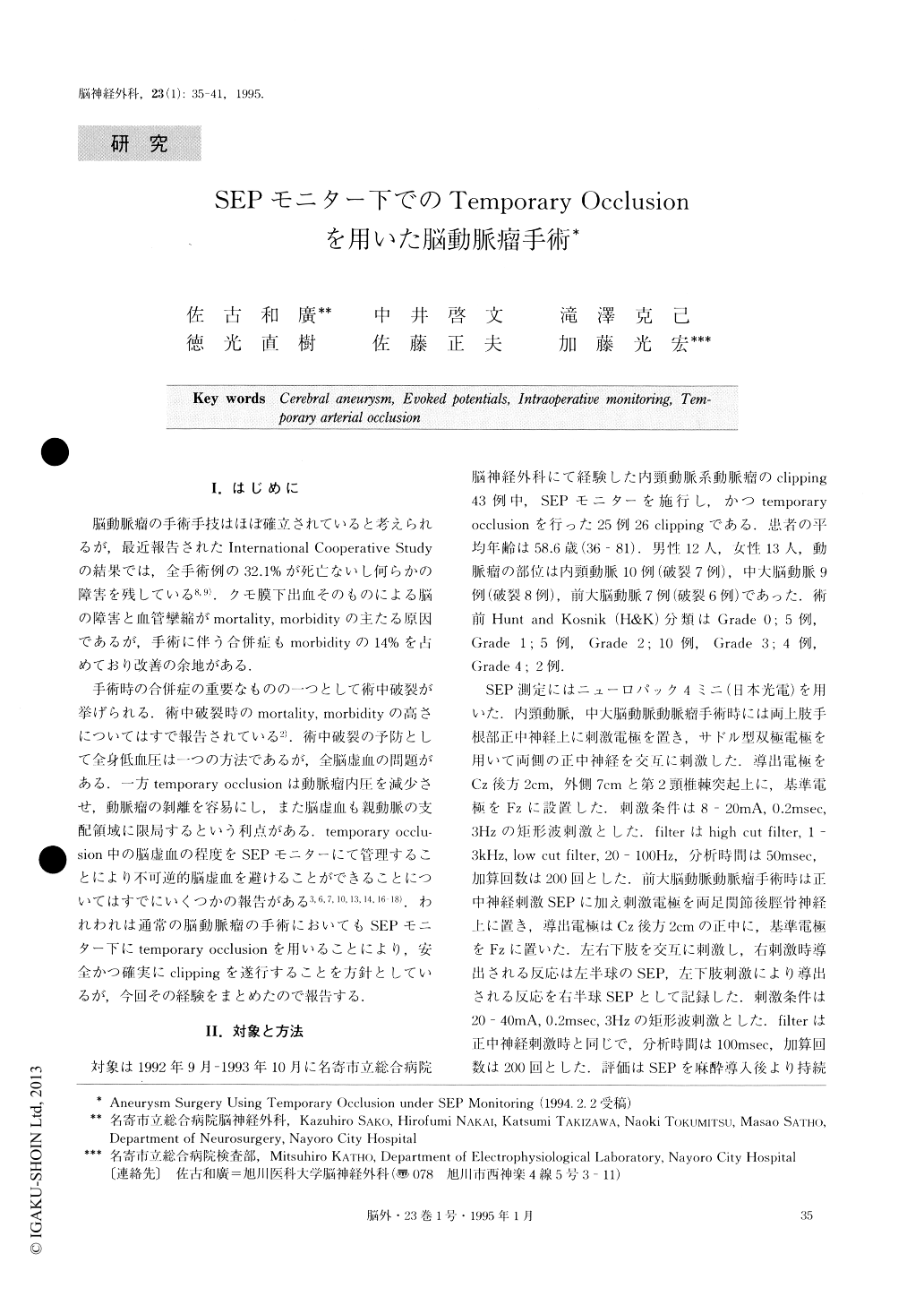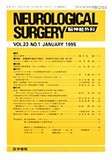Japanese
English
- 有料閲覧
- Abstract 文献概要
- 1ページ目 Look Inside
I.はじめに
脳動脈瘤の手術手技はほぼ確立されていると考えられるが,最近報告されたInternational Cooperative Studyの結果では,全手術例の32.1%が死亡ないし何らかの障害を残している8,9).クモ膜下出血そのものによる脳の障害と血管攣縮がmortality,morbidityの主たる原因であるが,手術に伴う合併症もmorbidityの14%を占めており改善の余地がある.
手術時の合併症の重要なものの一つとして術中破裂が挙げられる.術中破裂時のmortality,morbidityの高さについてはすで報告されている2).術中破裂の予防として全身低血圧は一つの方法であるが,全脳虚血の問題がある.一方temporary occlusionは動脈瘤内圧を減少させ,動脈瘤の剥離を容易にし,また脳虚血も親動脈の支配領域に限局するという利点がある.temporary occlu—sion中の脳虚血の程度をSEPモニターにて管理することにより不可逆的脳虚血を避けることができることについてはすでにいくつかの報告がある3,6,7,10,13,14,16-18).われわれは通常の脳動脈瘤の手術においてもSEPモニター下にtemporary occlusionを用いることにより,安全かつ確実にclippingを遂行することを方針としているが,今回その経験をまとめたので報告する.
Premature rupture of a cerebral aneurysm during op-eration is a serious hazard. Temporary occlusion of in-tracranial arteries has emerged as a valuable technical adjunct in the management of intracranial aneurysms. Twenty-five patients (from a group of 43 consecutive aneurysm patients treated during a 13-month period) underwent elective temporary arterial occlusion under somatosensory evoked potential (SEP) monitoring. Me-dian nerve SEPs were used during 19 ICA and MCA aneurysm operations, while posterior tibial SEPs only were used in 7 patients with aneurysm of the ACA. Amplitude of the N20 or P40 was evaluated. A de-crease in amplitude more than 50% when compared to baseline value was defined as a significant SEP change. In 11 patients of the 25 cases, SEP changes were observed. Temporary occlusion was applied to the prox-imal portion of the internal carotid artery 10 times, to the M1 portion of the middle cerebral artery 5 times, to the M1-M2 complex 5 times, to the Al portion of the anterior cerebral artery 9 times, and to the A2-A3 once. Of the 26 clipping (25 patients), 12 had SEP al-terations, 14 had no SEP changes. Temporary occlusion was released within 3 minutes after disappearance of N20 (or P40) in all the patients with SEP changes ex-cept one. Nine of these 11 patients showed complete re-covery of SEP and two showed partial recovery. Pa-tients with partial recovery of SEP were associated with postoperative new neurological deficit, which was transient in one of them. There was a correlation be-tween changes in SEP and post operative outcome. The postoperative angiography did not indicate that tempo-rary occlusion by the Sugita's temporary clips leads to angiographically detectable arterial wall changes. These results indicate that tolerance for vessel occlusion is un-predictable. This study suggests that temporary occlu-sion under SEP monitoring is a safe and useful techni-que for aneurysm surgery.

Copyright © 1995, Igaku-Shoin Ltd. All rights reserved.


